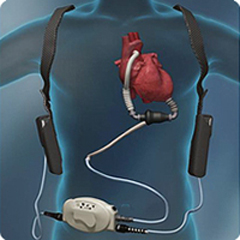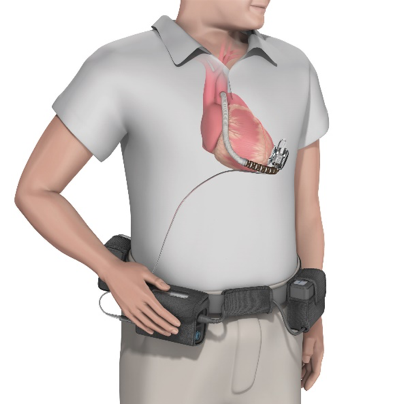A ventricular assist device is a treatment for advanced heart failure. It's an implantable heart pump that is recommended after you have tried other standard medical therapies, and your heart failure continues to worsen. There are several kinds of ventricular assist devices.
Left Ventricular Assist Device (LVAD)
The left ventricular assist device (LVAD) is the most common type. An LVAD supports the left ventricle of your heart, the heart's most important pumping chamber. An LVAD is used in two main situations:
- As a bridge therapy to support your heart while you are waiting for a heart transplant.
- As a permanent therapy (also called a destination therapy) for patients with advanced heart failure who are not eligible for heart transplant, usually because of age (being over 65 years old) or having certain types of cancer.

 The LVAD is implanted in the space immediately below the heart. The LVAD does not replace the heart, but runs in parallel to the heart — helping the left ventricle to pump more efficiently. An LVAD is small and silent, with a wearable power system that includes batteries and a small computer. Many patients with LVADs experience prolonged life, with the ability to do normal activities such as spending time with family, hobbies, driving, and traveling.
The LVAD is implanted in the space immediately below the heart. The LVAD does not replace the heart, but runs in parallel to the heart — helping the left ventricle to pump more efficiently. An LVAD is small and silent, with a wearable power system that includes batteries and a small computer. Many patients with LVADs experience prolonged life, with the ability to do normal activities such as spending time with family, hobbies, driving, and traveling.
There are several medical therapies that are very effective in treating heart failure, including medication and devices such as pacemakers and defibrillators. However, heart failure in some patients will eventually progress to the point where traditional therapies are no longer helpful.
You may want to talk to your physician about an LVAD if you have one or more of the following symptoms:
- You can no longer walk a block without shortness of breath
- Your doctor decreases your heart failure medication because you have low blood pressure
- You need more and more diuretic medication to control your weight
- You've been admitted to the hospital because your heart failure is significantly worse
- You have received cardiac resynchronization therapy (CRT) — a pacemaker-type device that corrects heart rhythm problems caused by heart failure — but your symptoms have not improved
- You are dissatisfied with the quality of your life
Temporary Ventricular Assist Device
A temporary (or percutaneous) ventricular assist device is a small mechanical pump that provides short-term support for the heart from a few hours up to 15 days. It is typically used to give your heart time to strengthen, if you have developed heart failure as a result of heart surgery or a heart attack. These devices can be placed in the cardiac cath lab.
Stories from those living with an LVAD:
© 2018 Intermountain Healthcare. All rights reserved. The content presented here is for your information only. It is not a substitute for professional medical advice, and it should not be used to diagnose or treat a health problem or disease. Please consult your healthcare provider if you have any questions or concerns.